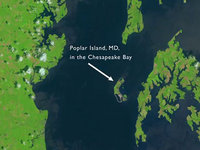US Army builds artificial mysterious island in Atlantic Ocean
The U.S. Armed Forces have increased the area of their country by 460 hectares. However, it does not go about the conquest of a territory during an armed conflict. The U.S. Corps of Engineers summed up the first results of a unique project to restore the land and deepen the seafloor in the Chesapeake Bay. Internet users monitored the progress of the work and suspected the presence of some insidious plans that the U.S. government harbors.

The Chesapeake Bay is the de facto a part of the Atlantic Ocean. The bay juts into the mainland - it is located between the states of Virginia and Maryland. There used to be numerous small islands in the bay. The islands were inhabited by tribes of Indians, and were later conquered by European colonists. Poplar Island was one of them.
About 100 years ago, the island diminished in size from 400 to not more than 10 hectares. As a result, the new territory of the island became located on three pieces of land. The rest of the island was simply washed away by the sea. About 15 years ago, U.S. authorities approved the financing of a unique project to restore Poplar Island. The work began in 1998. For the time being, the square of the island makes up 460 hectares.
The video recording, made from NASA satellite images, became quite a bombshell on the Western Internet and caused skeptical reactions from many Internet users. For example, the news about the restoration of Poplar Island was published on gizmodo.com under an ambiguous headline that it was the US Army that was building an island off the coast of the United States." In this regard, people wrote in the comments to the article that the story was about some secret military facility.
The island was discovered by Europeans in the second half of the XVI century, when Spanish conquistadors landed in the Chesapeake Bay area. European colonists settled there in the 1630s. Having cleaned the island from the indigenous population, they began to cultivate tobacco and some crops there. In the 1840s, the great-grandson of Charles Carroll, one of the signers of the American Declaration of Independence, settled on the island. The politician's descendant decided to establish a fur farm on Poplar. He brought more than a thousand of felines to the islands for the purpose. Fortunately, the knacker's yard did not last long. In winter, when the waters of the bay turned into ice, the felines escaped to the mainland, The Baltimore Sun wrote.
By the end of the XIX century, the island had split into three parts and then began to decrease rapidly in size. After another 100 years, only a few hectares of land were rising above the water.
In 1996, a U.S. Senate committee approved the allocation of $15 million to begin the work on the draft to restore the island. The total cost of the works for 25 years was the estimated at $307 million. In 2011, a recalculation showed that the spending had exceeded $660 million.
By design, the goal to restore the island was not the basic goal of the whole project. Poplar was supposed to be made something like a "latrine." The governments of the states that surround the Chesapeake Bay had been preoccupied were the problems of navigation for a long time. The depth of the bay in many areas, involving waterways, does not exceed 15 meters, making navigation complicated. For example, a Russian tanker ran aground in the Chesapeake Bay in 2008.
An ambitious project was proposed as a solution to the problem. It was offered to remove a layer of soil from the shallowest parts of the bay, particularly from the waters of the port of Baltimore and then take the soil to the area of Poplar Island. Ecologists would never allow dumping the collected mud somewhere near the coast. Thus, American officials were hoping to kill two birds with one stone: to solve the problem of navigation and restore the island.
The noble mission was entrusted to the U.S. Corps of Engineers of Baltimore County. The work began with creating a concrete frame around the perimeter of the future island that had been divided into cells. Next, the form was filled with the soil from the bottom of the bay, NASA said and published satellite images of the object.
The project for the construction of the artificial island did not meet any resistance on the part of environmentalists. There were only environmentally friendly materials used during the construction.
Nowadays, the island serves as a natural reserve. There are no predatory animals living on the island. Sea turtles and some bird species gradually retrieve their populations. It is not clear yet whether U.S. defense officials confirm the fears of vigilant Internet users or not.
Subscribe to Pravda.Ru Telegram channel, Facebook, RSS!


